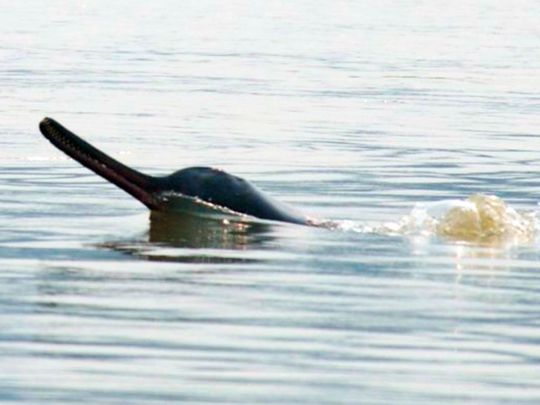
Kolkata: India’s national aquatic animal, the endangered Gangetic river dolphin (Platanista gangetica gangetica), is rarely visible in the waterways of the Indian Sundarbans.
And now a new study has shed light on the rise in salinity in the water and blamed reduced freshwater flow for the mammals’ disappearance in the iconic estuarine habitat.
A survey of a nearly 100-km stretch of the Sundarbans delta in India adjoining Bangladesh, has confirmed the presence of the dolphin populations only in the westernmost segment, in the lower reaches of the river Hooghly, where the salinity is lower than that of natural seawater.
The mammals keep away from the central Sundarbans, the survey found, where siltation in the waterways has disrupted freshwater flow, leading to high salinity levels.
The easternmost part of the Indian Sundarbans having freshwater connectivity with river Padma of Bangladesh is moderately saline but the salinity level increases downstream and the southwest part of Bangladesh Sundarbans is hyper-saline.
Published in the Journal of Threatened Taxa, the survey indicates a “possible decline in the range of Platanista gangetica in the Indian Sundarbans” attributing the extirpation to a triple whammy of elevated sedimentation, reduced freshwater discharge and swelling salinity.
India’s “Dolphin Man”, ecologist Ravindra Sinha agreed with the findings and observed that earlier, in the entire Sundarbans including different water channels and tributaries/distributaries one could spot the Ganges dolphins.
“Gangetic dolphins are obligatory freshwater animals and they never enter the sea. They are found in brackish water zones such those in the Sundarbans estuary. But freshwater flow has declined over the decades and seawater has ingressed, increasing the salinity. They are rarely visible now, whereas once they were plenty,” Sinha, Vice Chancellor Nalanda Open University, told Mongabay-India.
Inhabiting one of the most densely populated regions of the world, the Gangetic river dolphin is one of the only four surviving river dolphins globally, as the Yangtze River dolphin is virtually extinct, noted Sinha, one of the authors of the Conservation Action Plan for the Gangetic Dolphin 2010-2020.
The research team included Sangita Mitra (presently with National Biodiversity Authority, Chennai) and Mahua Roy Chowdhury, a marine biologist from the University of Calcutta, West Bengal.
“Significant increase in salinity levels were documented in the river Ganges in India after the commissioning of the Farakka Barrage,” the study said, referring to the project in West Bengal that began operations in 1975.
Looking at the pan-India scenario, Sinha explained the biggest threat to Gangetic dolphins is the declining flow in the river Ganga as erection of dams and barrages and water-intensive agriculture in the basin contribute to the base flow petering out and fragmenting their habitats.
Records dating to 1879 reveal the freshwater-loving mammals swam along the entire length of the Ganga and Brahmaputra rivers, and all their tributaries from the delta at the Bay of Bengal till the Himalayan foothills. Even in the month of May, when the Ganga was very low, dolphins were seen as far up the Yamuna in Delhi.












